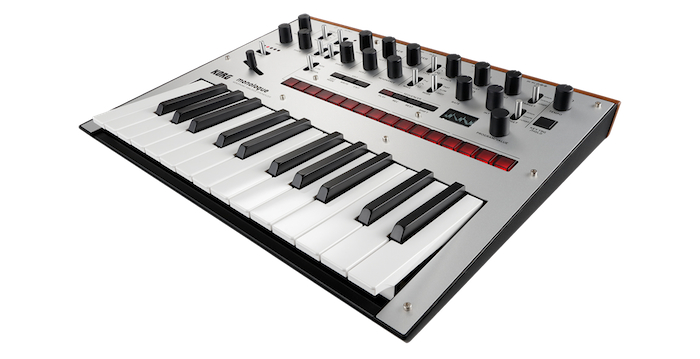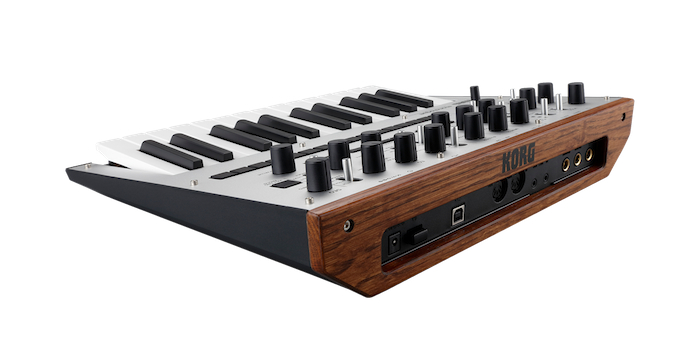New Gear Review: Monologue Analog Synthesizer by Korg

The monologue may be small in size, but don’t let that fool you—this fully-programmable synth has a tons of comprehensive features packed under its tiny hood.
If you’ve been following synth trends for any length of time, you’ve probably noticed that we are living in a world with a treasure trove of analog choices, both in monophonic and polyphonic varieties.
One of latest additions on the monophonic front is the monologue by Korg, a synth that boasts a new dual oscillator design, an OLED screen with a built-in oscilloscope, a sixteen-step sequencer, and comes in a choice of five colors. All these are features it shares with the slightly larger—and polyphonic— minilogue that Korg released earlier in 2016, causing quite a stir.
Both the monologue and minilogue were conceived and designed by Tatsuya Takahashi, who was also responsible for the monotribe and the volca keys, which proved to scratch an itch no one else had been scratching, by providing small desktop analog instruments with limited, but very useful, sequencers.
The success of the earlier monotribe and volca had paved the way for the minilogue, a four-voice analog polysynth that sold for under $500. The latter was such a huge smash upon its release that finding one was virtually impossible unless you were one of the few that had pre-ordered. So, among a slew of competitors (from both Korg and other companies) how does the monologue stand up?
Features and Use
Despite being fairly small in size, the monologue feels solid and sturdy, and the small keys were surprisingly playable—they feel like a completely different design than the microKORG, for example. The PCB-mounted potentiometers in particular felt solid and imparted confident tweaks. The monologue’s keyboard runs from E to E (two full octaves), which makes hitting those low notes when playing with stringed instruments that much quicker. Full size MIDI jacks on the rear are another welcome inclusion, breaking the recent trend of using mini jacks and proprietary adapters.
Both the mono- and minilogue have rear wood paneling, a sloped front panel, and a very handy OLED screen that is mostly used as an oscilloscope but also provides menu information when needed. This screen alone is going to make the monologue a hugely useful tool for beginner synthesists, allowing a real-time visual representation of the waveform that is fun to watch regardless of the depth of your understanding.
While much has been said about the minilogue and monologue sharing DNA, I would venture to call them distant cousins as opposed to direct siblings. This starts to become apparent when examining the monologue’s architecture, which is based around two oscillators. The first offers sawtooth, triangle, and square waves, while oscillator two offers sawtooth, triangle, and noise waveforms, with the ability to sync and ring mod.
Oscillator one has a somewhat limited range on the sawtooth wave, but the trade-off is that the triangle wave does extend down to those sub frequencies, albeit losing some range in the treble. The second oscillator offers a wider range, and one of the most handy features of the aforementioned OLED screen is the ability to see the precise amount of detuning that oscillator two has applied against oscillator one. This made setting intervals between the two a snap. The monologue also offers individual volume controls for each oscillator, making dialing the mix between the two more fine-tuned than the usual slider formation where it’s an either/or choice.
One of the most unique features of the monologue that is shared with the minilogue is the “Shape” knob, which provides timbral variations by altering the harmonic overtones, octave range, and wave folding of each wave shape. Modulating this via the step sequencer is an easy way to achieve movement that would set you back one LFO on a synth with a less flexible architecture, and using the step sequencer in this way allows you to overcome some of the quirkier design choices (see: envelopes, below).
The filter is a 2-pole, 12dB/octave design that reminded me of the LPF on previous Korg synths like the MS-10 and MS-20. There is definitely plenty of acid-y squelch on tap, and I found the resonance to be greatly effected by the built-in drive control—these two knobs had a huge amount of interaction. Something worth noting is that velocity can be used to control the filter as well, though this feature is only accessible via a quick dip of menu diving.
I found the filter worked best on sounds that were on the aggressive side of the spectrum. Softer tones still had depth and presence, but had less character than the biting leads and full, saturated basses that were easily programmed with a few quick knob turns. The filter can self-oscillate and be used as a tone source, creating a 3rd oscillator, allowing chords to be played with careful tuning, as showed in a skillfully programmed preset.
The monologue’s sequencer will be familiar to those who have used both the volca and the minilogue. Settings can be changed as the sequencer is playing (i.e. shortening the length of the sequence, gate time, swing, and step resolution—very handy). Motion sequencing is much easier than on the minilogue due to the fact that you can now see and edit modulation lanes on the incredibly detailed screen.
Holding down a step (or several at a time) allows you to edit parameters for that step, in a design nod that hearkens back to Elektron’s “Parameter lock” system. The sixteen buttons of the sequencer also make accessing and editing menu parameters incredibly quick and intuitive. The sequencer can be transposed (unlike the one on the minilogue) with the key trig/hold button. Adding slides to a pattern in the sequencer is incredibly easy and makes the monologue a hugely capable acid machine, even without the characteristic roundness typically associated with Roland’s TB-303. Unfortunately there is no way to copy patterns between patches without also copying the patch itself.

Aside from its sturdy build quality, the monologue offers a classy look, thanks to its sleek wooden back panel—a feature shared with its polyphonic counterpart, the minilogue.
The envelope and LFO sections on the monologue are where a few omissions have been made. The envelope is streamlined into a single knob, plus a switch to activate sustain. Similarly, the LFO has two modes, one of which activates the LFO as a one-shot hit, effectively allowing it to be used as a second, simpler envelope. I still would have liked to have a separate full envelope for the filter, but only so much real estate is available on an instrument of this size. It’s also worth nothing that the LFO can modulate at extremely high rates, adding some FM- and formant-like sounds to the monologue’s subtractive synthesis palette.
While these features are slightly stripped back compared to the full ADSR envelopes available on competing analog monosynths, the monologue has a few things that are fairly unique and set it apart from the crowd.
One of these features is the ability to set your own tunings, including micro-tunings of your choosing. Richard D. James of Aphex Twin fame was notably called upon for his programming prowess, and several presets and micro-tunings in the monologue are his work. But where this feature really stands out is the ability to store each preset as a key of your choice, and thus not ever having to worry about hitting a note out of scale! Adding to the fact that each preset can store its own pattern and tuning, this makes setting up a chain of patterns for a performance a snap. It made me wish the monologue had the ability to store more than 100 presets, as I quickly began to fill up the memory just using a few simple variations and a range of patterns.
The drive knob, which is conveniently placed right under the volume knob, is one of the best and most useful features of the synth, especially when coupled with the Shape controls. It was very easy to get a rich, saturated tone or a harsh and buzzy rasp, depending on filter settings. A small but appreciated detail is that the knobs offer the ability to jump, catch, or scale when changing patches to different knob values than what is displayed on the panel. This is something that was inherited from the electribes, and makes a huge difference when avoiding “knob jumping” during live performance.
To Be Critical
If I had any complaints, the biggest would be that the lack of arpeggiator makes the monologue slightly less useful for quick, rhythmic bass parts. Even though the sequencer is fairly easy to program, I still missed having the ease of a dedicated arpeggiator. Similarly, even though the monologue’s filter and drive circuit can process audio via a rear jack, there’s no way to control the level of that signal, making that feature only useful in certain studio situations.
Summing it Up
Overall, the monologue proves itself as a highly capable instrument in a crowded field, not just as a rowdy bass machine but as an experimental sound design tool when using the sequencer and modulation capabilities to their fullest extent. Priced fairly at $299, it would be a valuable addition to the arsenal of anyone in the market for a compact yet flexible and intuitive analog monosynth.
If you’re seeking only retro tones or crystal clear bells and leads, I’d suggest looking elsewhere, but if you’re ready to dive deep into murky waters and make an instrument your own, the monologue is ready when you are.
Leo Maymind is a producer, DJ, and writer living in Los Angeles, CA. He is obsessed with sound and can be reached at lmaymind@gmail.com.
Please note: When you buy products through links on this page, we may earn an affiliate commission.







Tommy Lee
August 29, 2017 at 2:28 pm (8 years ago)The big mistake is the extremely limited space for your own presets…. BUMMER!!!
Kristian Thinning Andersen
September 4, 2017 at 12:24 pm (8 years ago)You can store up to 99 presets..That’s hardly “extremely limited.